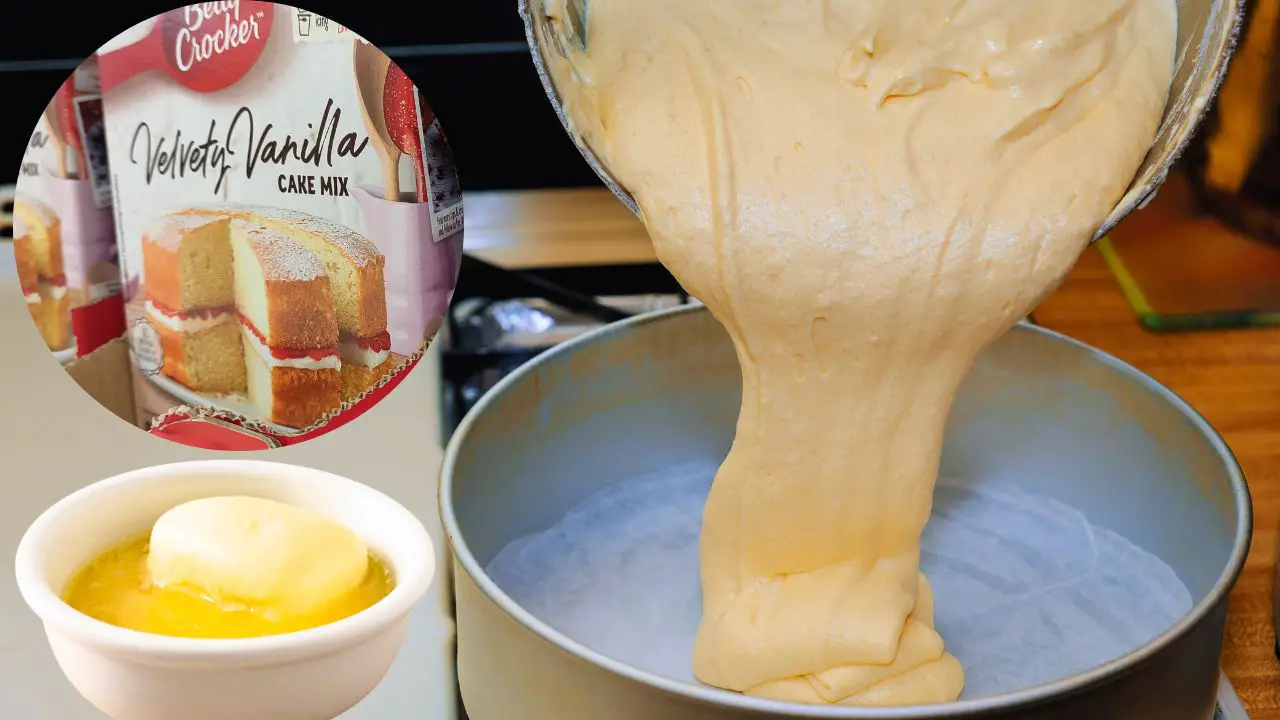We all know that most cake mixes call for oil, but have you ever wondered what would happen if you used butter instead of oil in a cake mix?
Will this seemingly simple substitution bring about a baking revolution in your kitchen, or will it end up in a cake disaster? I’m here to share my experience, some prose, and cons of using butter instead of oil in cake mix and the best way to do it.
So, Why Do I Prefer Substitute Oil For Butter In Cake Mix?

I can confidently confirm that I like butter better after making dozens upon dozens of cakes using boxed cake mixes. That also goes for brownies. It’s a matter of taste, but my family’s feedback always confirms that when I substitute oil for butter in cake mix, the resulting cake is so good you might never guess it comes from a store-bought cake mix.
Butter adds an extra layer to the flavor—a certain depth and richness that oil lacks. The texture is also more to my liking; a bit denser with smaller crumbs.
You might think that most cake mixes ask you to use oil because it’s the only option. After all, maybe using anything else could ruin the preparation, right?
Not exactly. Fat is all a cake needs to transform from a batter into a fluffy dessert, and many types of fat exist.
Read Also: How To Improve Boxed Cake Mix (15 Clever Hacks).
The Science Behind Baking With Fats

Before explaining the practical differences between butter and oil in baking, I have to get a bit scientific and talk about chemistry. Bear with me; I promise it’s important!
The key to understanding why you should bake with butter or oil lies in understanding two basic things: the role fats play during baking and the differences in types of fat.
Why Do We Add Fat to Cake Mixes?

In short, fats provide two key elements to any cake: tenderness and moisture—or at least the illusion of it.
The long story? Fats are responsible for a good chunk of what makes cakes delicious in the first place. That deliciously creamy sensation each time you eat a slice of a cake? The melt-in-your-mouth texture after each bite? All fat.
Fats coat the flour and prevent it from absorbing water or losing extra moisture during baking, stunting gluten development and weakening it. The result is a cake that is softer and fluffier. This process also gives the illusion of moisture since fat does not evaporate under intense heat, resulting in a “wetter” cake despite having no water.
However, not all fats are made equal.
The Two Main Types of Fat
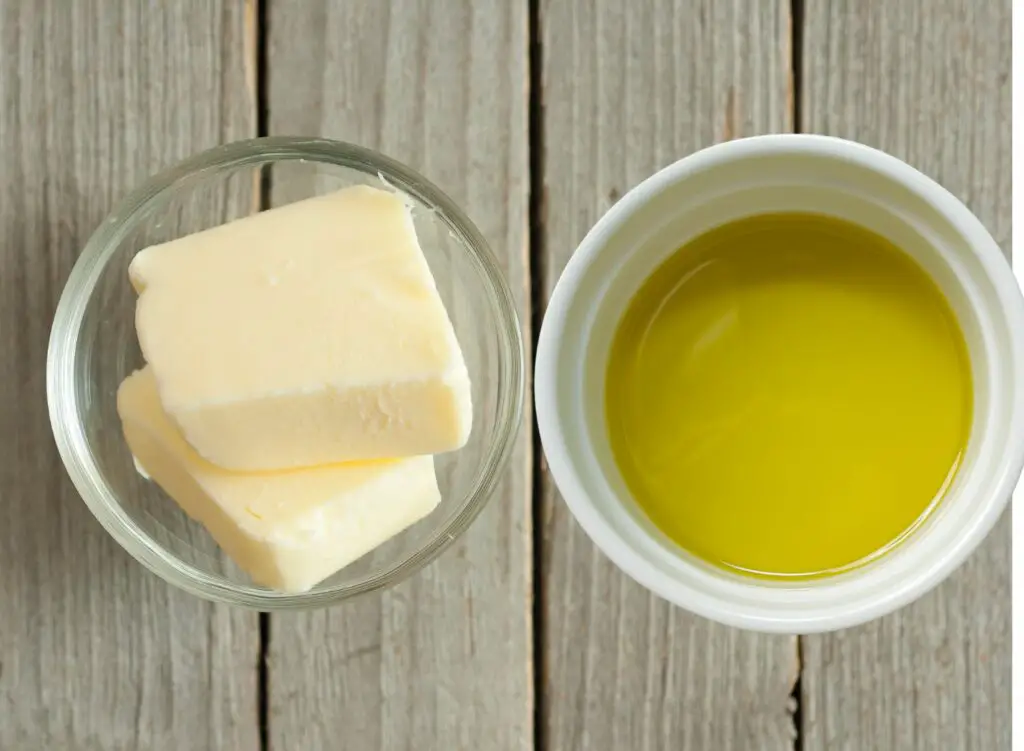
While all fats add tenderness and the illusion of moisture, they do it to varying degrees and with some differences. And in baking, you need to consider two main fat types: saturated and unsaturated.
There are many more differences between these two types of fat—chemically, nutritionally, and more. However, for baking purposes, you need to know that they react differently to temperature.
Saturated fats tend to have animal origins, although some are plant-sourced. They remain solid at room temperature and turn liquid with heat.
Unsaturated fats, on the other hand, often come from vegetable sources and stay liquid at room temperature.
And herein lies the main chemical difference between butter and oil—butter is a saturated fat that solidifies at room temperature, while oil remains liquid. But what does that mean for cakes?
The Differences Between Butter and Oil For Cake Mixes
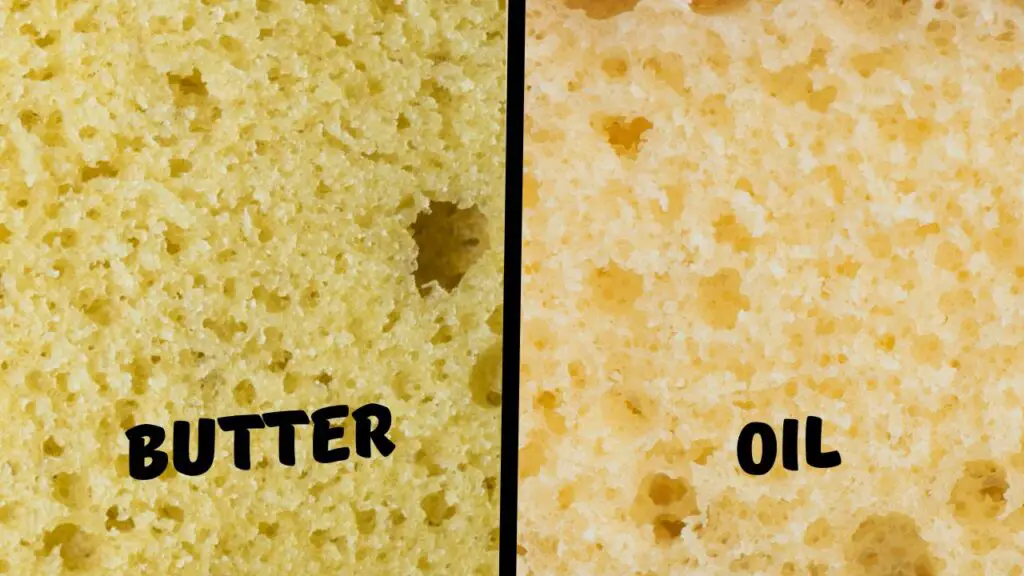
Now that we approached saturated and unsaturated fats, it’s time to discuss how those ingredients’ differences affect cakes.
1. Butter Makes Cakes Dense. Oil Makes Cakes Moist
Oil, as an unsaturated fat, remains liquid at room temperature. That means cakes made with oil will stay moist and soft long after baking, although they can have an oily finish that can feel rather greasy and may not be everyone’s cup of tea.
Contrastingly, butter can turn solid. This means that, with time, it may become tougher and drier, but it has a silkier finish without any oiliness.
Another aspect worth considering is that butter is not just fat—it has a percentage of water and moisture. This moisture will bond with the flour and create gluten, which means cakes made with butter will be more solid and structured. On the other hand, that same water will evaporate while baking, causing the cake to rise a bit more.
2. Butter Adds Flavor. Oil (Mostly) Does Not
Butter has over 80% of butterfat, which imparts a distinctive flavor. The milk solids add extra creaminess and a flavor that enhances the baseline taste of nearly every single type of cake. In the oven, cakes made with butter get a beautiful golden-brown color and a crisp exterior thanks to the cooked milk solids, which create a lovely contrast with the moist interior.
On the other hand, the more generally-used oils, such as canola or vegetable, tend to have a very neutral and barely perceptible taste. You can always use flavored oils to add an extra touch to your cakes, but they tend not to be as versatile and may clash according to the recipe.
3. Oil Makes Cake Last Longer. Butter Does Not.
The shelf-life of oil-made mix cakes tends to be longer. Since oil preserves its texture regardless of temperature, refrigerated cakes made with oil tend to keep that soft and moist texture even after being cold.
However, Cakes made with butter can lose their moisture and become tougher with time. Likewise, the milk factors in the cake mean it can spoil much faster if left at room temperature for long.
When Should You Use Butter or Oil For Cake Mix?
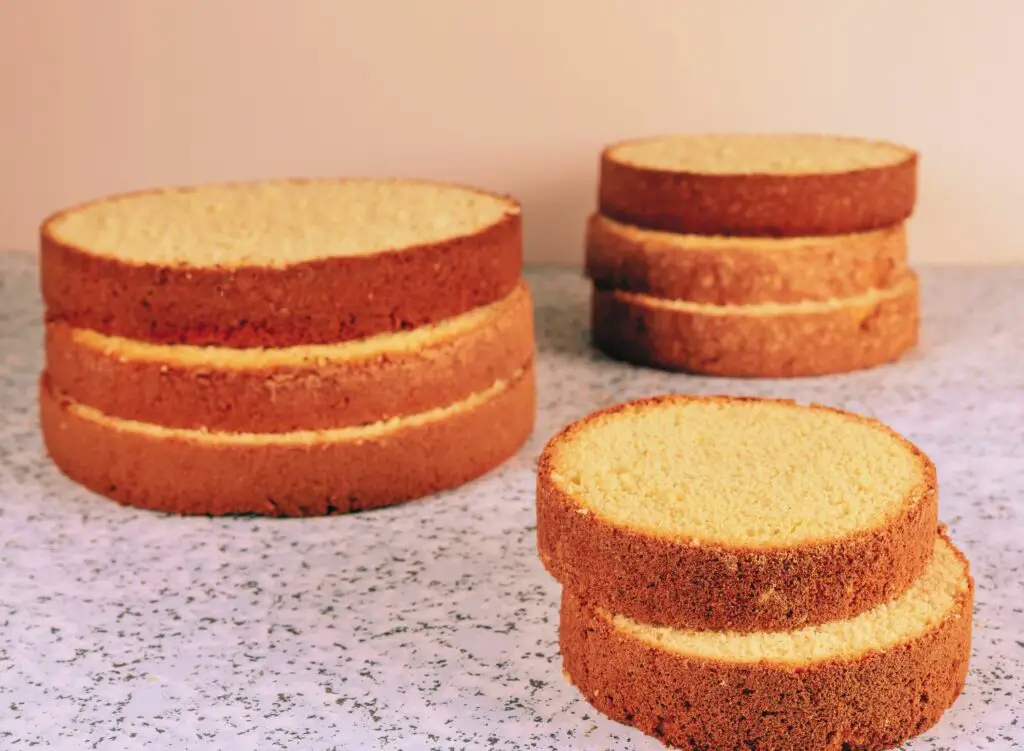
Although you can use butter or oil wherever you want, there are slight advantages of using one over the other in certain recipes or circumstances.
For example, butter is the best option to make cakes from a ready-made cake mix if you need to stack or decorate them. Since butter makes cakes denser and more structurally stable, you’ll have a better base to work on when compared to the lighter and softer texture of oil cakes.
On the other hand, certain flavors may pair better with oil or butter. For example, chocolate cakes dry out much faster, so oil may make them moist for longer if you do not mind an oily finish.
However, remember that these simple rules do not apply when making a cake from scratch. Cake mix often includes chemical leaveners such as baking powder or baking soda, so you’re guaranteed your cake will rise.
But suppose you’re making a cake from scratch. In that case, you need to pay attention to the recipe—creaming butter with sugar often provides some mechanical leavening, so if you’re replacing butter with oil, you’ll need to make up for the loss of that aerating since oil does not help cakes rise the way butter does.
How to Substitute Butter for Oil in Cake Mix and Vice Versa
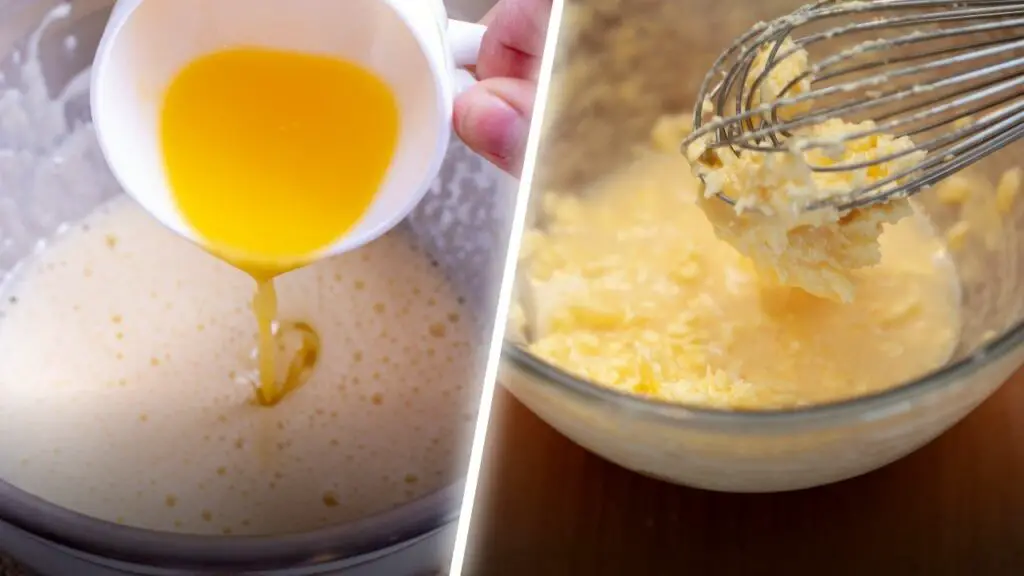
So, you want to know how to switch between using butter and oil when you’re making a cake from a mix, right? The key thing to remember is that these swaps aren’t a straight trade. But don’t worry; it’s simpler than it sounds.
Let’s say you want to use butter instead of oil. Just replace the same amount of oil that the recipe asks for with butter. For example, if the recipe says one cup of oil, just use one cup of butter instead. Easy peasy, right?
One thing, though, you’ll have to cream the butter or melt your butter first. It is certainly easier to just melt the butter and turn it from a solid to a liquid.
Of course, you can always use solid butter and aerate it beforehand if you want, but remember that the results may differ from what you expect. Likewise, make sure to let the butter cool down after melting.
Now, what if you want to do it the other way around and when the recipe calls for butter, but you want to use oil instead?
That’s a bit trickier. If the recipe calls for one cup of melted butter, you should only use ¾ cup of oil. That’s because oil is just fat, but butter has some water and milk stuff in it. Using less oil makes sure your cake doesn’t get too greasy.
So, What Are The Pros Of Using Butter Instead of Oil in Cake Mix?

Whenever I can, I prepare cake mix with butter rather than oil. But just because I like it more doesn’t mean you have to!
To sum up, here are the pros of ditching oil and going with good, old butter:
- The flavor is layered and richer. All cakes get an extra push thanks to the milky, buttery undertaste you get, meaning a more complex-tasting cake that doesn’t seem out of a box but rather homemade, made from scratch.
- The cakes are denser and better structured yet remain fluffy and airy enough. It’s the perfect cake texture, withstands stacking, decorating, and anything else you’d like.
- The texture is silky smooth and pleasant to the palate, without the oily layer at the top that you get from using any sort of vegetable oil.
- Cakes made with butter tend to brown in the oven and get a stunning golden brown color. Likewise, they get a crispy outer layer while remaining soft and moist inside.
- You can always brown the butter manually to impart a slightly more flavorful, nutty undertaste to your cakes.
Here Are The Downsides Of Using Butter In Cake Mix

Nothing is perfect. Although I love using butter in my cakes, I’m aware I have to sacrifice some perks of using oil for the sake of that delicious cake crust.
So, to keep things balanced, look at the disadvantages of using butter rather than oil.
- Cakes made with butter dry out faster, so if you’re not planning to eat them soon, you may end up with an unpleasant and dry cake after two days.
- Your cake made from a box mix will be moister if you use oil, which many people prefer.
- Oil is easier to use than butter since you need to melt and cool the oil to follow the instructions in the cake mix properly.
- Butter has a distinctive taste, which may clash with other ingredients in your cake. If you dislike the taste of butter, you may not like it.
- Butter isn’t vegan, which may clash with some people’s preferences.
Related Post: Two-Ingredient Soda Pop Cake (11 Combinations You Should Try).
In Conclusion
While the traditional choice for cake mix is oil, using butter instead of oil in a cake mix can add depth of flavor, give a denser texture, and produce a golden-brown crust that’s hard to resist.
However, it’s important to consider some of its downsides, like the potential for drying out faster, a little more effort in preparation, and its non-vegan nature.
Nevertheless, substituting oil for butter in the cake mix is certainly worth trying if you’re looking for a rich and flavorful twist to your regular box mix cake. Remember, in the world of baking, experimentation is the key to discovering new and delicious creations!
